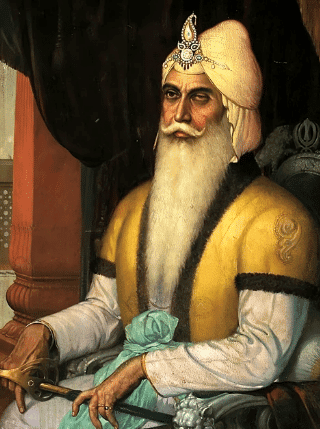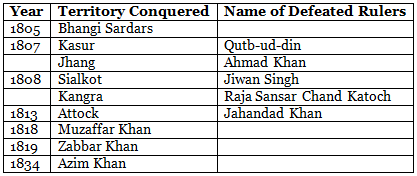Maharaja Ranjit Singh | Punjab State (PPSC) PSC: Preparation - PPSC PCS (Punjab) PDF Download
Introduction

- Birth and Early Life: Maharaja Ranjit Singh was born on November 13, 1780, in Gujranwala (now in Pakistan) into a Jatt Sikh family of the Sandhawalia clan. His father, Maha Singh, was the head of the Sukerchakia Misl, one of the twelve Misls in Punjab. After his father's death, Ranjit Singh became the leader of the Sukerchakia Misl at the young age of twelve.
- Rise to Power: Ranjit Singh united the Sikh Misls and took control of other local kingdoms, establishing the Sikh Empire. He captured Lahore in 1799 and made it his capital. Over the next few years, he expanded his territory, bringing Central Punjab under his control and extending his kingdom from Ladakh in the North to Shikarpur in the South, and from Jamrud in the North-West to the Sutlej River in the East.
- Proclamation as Maharaja: In 1801, Ranjit Singh proclaimed himself the "Maharaja of Punjab." He referred to his rule as "Sarkar Khalsa" and his court as "Darbar Khalsa." He also ordered new coins to be issued in the name of Guru Nanak Dev Ji, known as the Nanakshahi.
- Treaty of Amritsar (1809): On April 25, 1809, Ranjit Singh signed the Treaty of Amritsar with the British, agreeing not to occupy territory south of the Sutlej River and withdrawing claims over the rulers of that territory. This treaty established friendly relations between Ranjit Singh and the British.
- Expansion and Conquests: Ranjit Singh continued to expand his empire by capturing Kashmir, Peshawar, and Multan, and defeating the Yusufzai tribes north of the Kabul River. The Battle of Jamrud in 1837 and his march through Kabul in 1838 marked the last major confrontations between the Sikhs and the Afghans, helping to establish the western boundaries of the Sikh Empire.
- Legacy: Maharaja Ranjit Singh is remembered as a skilled military leader and unifier of the Sikh Misls. Despite being illiterate, he was known for his military prowess and ability to inspire loyalty among his followers. His leadership laid the foundation for the Sikh Empire, which existed from 1799 to 1849.
In 1838, a significant agreement known as the Tripartite Treaty was established, with Maharaja Ranjit Singh playing a crucial role. This treaty aimed to install Shah Shuja as the King of Kabul, backed by British and Sikh forces. Maharaja Ranjit Singh, who had previously reclaimed the famous Koh-i-noor diamond from Shah Shuja, passed away in Lahore on June 27, 1839, due to paralysis.
Territories Conquered by Maharaja Ranjit Singh

Administration System Under Maharaja Ranjit Singh
Maharaja Ranjit Singh was known for his efficiency and capability as a ruler. He divided his kingdom into four provinces: Lahore, Multan, Kashmir, and Peshawar, each overseen by a Nizam with the help of Kardars or collectors. To enhance control, Ranjit Singh organized the central administration into twelve departments.
The four important departments were:
- Daftar-e-Abwab-ul-Mal: This department managed the state's income and kept detailed records.
- Daftar-e-Taujihat: Responsible for tracking all expenses related to the royal family.
- Daftar-e-Mawajih: This department maintained records of salaries for various civil and military officials.
- Daftar-e-Roznamcha-Ikharjat: Responsible for keeping accounts of daily expenditures.
Land Revenue System Under Maharaja Ranjit Singh
During the reign of Maharaja Ranjit Singh, there were no major changes to the land revenue assessment system. Traditionally, one-third to one-half of the produce was taken as land rent or revenue.
Introduction of Batai System:
- The Batai system was introduced at the beginning of Maharaja Ranjit Singh's reign and continued until 1823.
Transition to Kankut System:
- In 1824, the Batai system was replaced by the Kankut system of assessment.
Revenue Collection Process:
- Land revenue was collected twice a year.
- The chief officer in charge of collection in a district was called the Kardar, assisted by subordinate officials such as Muqadams, Patwaris, and Kanungos.
Revenue Proceeds:
- Proceeds from the revenue were kept in the district treasury under the control of the Kardar.
- These proceeds were either sent to Lahore or disposed of according to the orders of the Central Government.
Army Under Maharaja Ranjit Singh
Ranjit Singh established a powerful army following European standards, dedicating one-third of his total revenue to military expenses. He enlisted two officers, Jean Baptiste Venture and Jean Francois Allard, from the disbanded army of Napoleon Bonaparte, to train his forces.
Court Administration Under Maharaja Ranjit Singh
Ranjit Singh was a secular ruler who transcended communal biases, appointing competent individuals from all faiths— Sikh, Hindu, and Muslim —to high positions in his court. His Foreign Minister, Fakir Aziz-ud-din, was a Muslim; his Finance Minister, Dina Nath, was a Brahmin; and his Prime Minister, Dhian Singh, was a Dogra.
A devout Sikh, Ranjit Singh considered himself a humble servant of Guru Nanak Dev Ji and made significant donations for the upkeep of shrines, including Gurdwaras, Dargahs, and Hindu temples. He also issued a commemorative coin known as the Nanakshahi rupee.
Successors of Maharaja Ranjit Singh
Kharak Singh (1801-1840):
- Kharak Singh, the eldest son of Maharaja Ranjit Singh, became the ruler of the Sikh Empire in 1839 after his father's death.
- He faced opposition from his younger brother, Sher Singh, in his bid for the throne.
- Kharak Singh proved to be a weak ruler, lacking the strength and focus needed to manage the affairs of the state effectively.
Nau Nihal Singh (1821-1840):
- Nau Nihal Singh was the son of Kharak Singh and Chand Kaur, and he married the daughter of Sham Singh Attariwala.
- At just 19 years old, he became the ruler after his father's death.
- Despite his young age, Nau Nihal Singh was ambitious, skilled in administration, and a capable soldier.
Chand Kaur (1802-1842):
- Chand Kaur was the wife of Kharak Singh.
- After the deaths of her husband and son, Nau Nihal Singh, in November 1840, she claimed the throne for herself.
Sher Singh (1807-1843):
- Sher Singh was the son of Maharaja Ranjit Singh and Mehtab Kaur.
- With the support of Dhian Singh, he ascended to the throne on January 20, 1841.
- Dhian Singh was appointed Chief Minister.
- Sher Singh's reign was cut short when he was murdered on September 15, 1843.
Dalip Singh (1838-1893):
- Dalip Singh was the youngest son of Maharaja Ranjit Singh and the last Sikh sovereign of Punjab.
- After the assassination of Maharaja Sher Singh, Dalip Singh was proclaimed Maharaja of Punjab at the age of five, with Hira Singh Dogra as his Chief Minister.
- His reign lasted from 1843 to 1849.
|
23 videos|50 docs|47 tests
|
FAQs on Maharaja Ranjit Singh - Punjab State (PPSC) PSC: Preparation - PPSC PCS (Punjab)
| 1. महाराजा रणजीत सिंह की प्रशासन प्रणाली की विशेषताएँ क्या थीं? |  |
| 2. महाराजा रणजीत सिंह के शासन में भूमि राजस्व प्रणाली कैसे कार्य करती थी? |  |
| 3. महाराजा रणजीत सिंह की सेना की संरचना कैसी थी? |  |
| 4. महाराजा रणजीत सिंह के दरबार की प्रशासनिक विशेषताएँ क्या थीं? |  |
| 5. महाराजा रणजीत सिंह के शासन के दौरान सामाजिक और आर्थिक सुधारों का क्या महत्व था? |  |





















